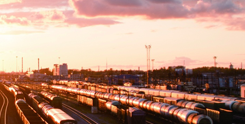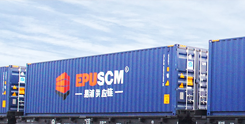Witness the Growth of China-Europe Banlie
Publishdate:2019-04-17 Views:884

Witness the Growth of China-Europe Banlie
—— Interview with Zhang Wen, Minister of International Intermodal Transport of China Railway Container Transport Co., Ltd.
Yang Haixia

导 读
Guide reading
With the opening of the Central European Band, the Eurasian continent has not only rediscovered the great potential of Eurasian trade, but also brought new space for investment and capacity cooperation along the line.
The previous year was a visitor, and the next year was a company representative.
Reshaping the Industrial Chain
"Now, the return cargo of our China-Europe liner has reached 71% of the journey. Slowly, the market has opened up. We believe that with the first China Import Expo held in November, a large number of imported goods will come through the Central European Ban. Zhang Wen, Minister of International Intermodal Transport of China Railway Container Transport Co., Ltd., said in an interview with China Investment magazine.
From the start of trial operation in 2011, by October 2018, China and Europe have carried out 11,000 queues. China Railway Container Company, a subsidiary of China Railway Corporation, as the whole-process unified operation service platform of the China-Europe train and the Secretariat unit of the China-Europe train transport coordination committee, has always been committed to the planning and design, marketing expansion, service guarantee and coordinated promotion of the China-Europe train. Zhang Wen has gone through the whole process from scratch to flourishing gradually. He has followed the Central European Ban Line to every station for many years, witnessing the changes brought about by this new trade route.
In his view, with the opening of the Central European Band, the Eurasian continent has not only rediscovered the great potential of Eurasian trade, but also brought new space for investment and capacity cooperation along the line.
"The previous year was a visitor, and the next year was a company representative."
Investment in China: China-EU Banquet has rediscovered the great potential of Eurasian trade. After several years of rapid development, what do you think is the greatest significance of China-EU Banquet? What changes have you seen in the promotion of the Central European Class in foreign countries all the year round?
Zhang Wen:
China-Europe Banquet can be positioned as a new choice of international logistics across Europe and Asia. In the past, international logistics was dominated by sea transportation and supplemented by air transportation. Air transport is generally for high-quality goods and goods with high transport time requirements, and the price is expensive, while sea transport is the choice of bulk products, time-sensitive goods, and the price is relatively low. It is precisely between the two that China and Europe Banlie has given customers a new choice.
But in fact, it is not only a simple mode of transportation, but also a channel of trade. In fact, under the background of the "one belt and one way" initiative, China and Europe have shown great vitality, or that the China Europe cooperation fits well with the "one belt and one road" initiative, which embodies the five links put forward by the "one belt and one road initiative".
First of all, the China-EU train has promoted the interconnection and construction of railway infrastructure and logistics facilities in various countries. In addition to the trunk roads we are familiar with, there are actually many branch lines in the Central European Banquet. As the influence of the Central European Banquet expands, with the increase of traffic volume, the capacity of the main roads can no longer meet the demand, and the number of branch lines and cities is also increasing.
Take Poland as an example. In the past, Poland's international trade was mainly carried out through Malashevich, an important port. Now it is not enough to rely on only one port. They are increasing investment in port construction to adapt to and carry on the Sino-European Banquet.
Another example is the German port of Duisburg. Hamburg used to be Germany's main port, Duisburg Port is an inland port, now with the opening of the Central European Banquet, has led to the improvement of Germany's inland waterways, highways and logistics facilities. At present, Duisburg Port's yards and warehousing facilities have been fully operated. In order to support the Central European Banquet, they are also strengthening the transformation and actively expanding the port.
Another example is Zhongbai Logistics Park. In the past, there was no railway, although it was only seven kilometers short, but now we are planning to build the railway directly to the logistics park, which will lead to a larger investment.
Banlie is not a single thing in China and Europe. There are some differences in the policies of railway transportation, customs and other aspects in each country. Although there are two major international organizations - Railway Cooperation Organization and International Railway Intergovernmental Organization, their organizational rules are broad. Specifically for the transportation of the Central European Banquet, there are many issues related to policy communication. With the rapid development of the Central European Banquet in recent years, the policy communication between countries and industries has become more and more vigorous and effective. A more obvious example is the customs policy. In recent years, customs inspection and Quarantine has increased cooperation and communication with the customs authorities of the countries along the lines around China and Europe. A series of measures have been introduced to facilitate customs clearance. Since August 1, Customs has implemented "single window" to integrate customs inspection. On the eve of the "Summit Forum on all sides", China Railway and six countries' railways signed an agreement on deepening cooperation between China and Europe. In addition, policy communication has also been strengthened between the countries and cities that are the counterparts of provinces and local governments.
There is also financing. At present, the value of goods transported by the Central European Banquet has exceeded tens of billions of RMB annually, which has led to a large amount of capital exchanges among countries along the route, attracted a lot of investment and financing for infrastructure, transport equipment and other capacity expansion and transformation, and effectively promoted the financing among countries along the route.
It is also intuitive in the connection of people's hearts and minds. Around the class of China and Europe, people at home and abroad have frequent exchanges, which has led to cultural exchanges. At present, many foreign companies have set up offices in China, and Chinese enterprises have set up branches abroad.
I personally have some personal experience, that is, after the development of China-Europe Banliang, many opportunities have been created for overseas students and Chinese. For example, every time we go abroad to promote, there are many foreign students to visit. The first year is to visit, and the second and third years are to become representatives of major foreign companies, so this is a very meaningful thing.
Therefore, the Chinese and European trains are not only international intermodal trains, but they really carry and reflect the concept of "one belt and one road initiative".
Reshaping the Industrial Chain
"China Investment": As you said, when the line is unblocked, the regional market will automatically start matching resources and allocating resources. Both sides have tapped many opportunities for cooperation in trade and investment. In the future, it is possible to restructure the industrial chain of the whole Eurasian continent? From your experience, is there such a trend?
Zhang Wen:I believe that the restructuring of the industrial chain is certain, which is an inevitable trend.
In China, one example is the timber industry. The earliest plate imported by China and Europe is Wuhan, which itself is a traditional wood wholesale base in China. Because there are fewer and fewer timber in China and a large number of imports are needed, around the increase in timber traffic brought by the Central European Banliang, Wuhan has adjusted its industrial planning (because this logistics channel is too convenient), upgraded the original simple wholesale timber base to timber processing and furniture manufacturing base, as their industrial transformation development goals.
And Chongqing. Chongqing does not produce coffee locally. Coffee is mainly produced in Yunnan Province. Coffee is first transported to Chongqing and then to Europe through the Central European Ban train. Chongqing began to develop coffee rough processing because of the increasingly dense class in China and Europe. Then, they proposed to do a coffee trading platform, because they found that there is no coffee futures trading center in China, the actual production is in the domestic market, but futures trading in foreign futures trading centers, so it put forward this goal, and particularly meaningful, this is a transformation from a coal mining enterprise.
Look at West and Central Asia. At present, grain in Kazakhstan and cotton in Uzbekistan are all transported through the Central European Banquet. There is an enterprise in Xi'an that loves chrysanthemum grain and oil. It used to be processed in Xi'an. Because of the convenient transportation, the grain processing plant was built directly in Kazakhstan, which is also the extension and forward of the industrial chain.
In Europe, Duisburg Port, Madrid, Rhodes and so on are not traditional freight centers. Now, through the development of the Central European Banquet, they have developed into an active and competitive logistics base. Railway facilities in Europe are perfect, but European railway freight has been on the decline for decades, and the railway revitalization has been revitalized by the shift between China and Europe. Moreover, railway transportation is one of the most environmentally friendly modes of transportation, so it is becoming more and more popular.
In addition, many enterprises have grown up with the help of the Central European Banquet, including China and other countries. For example, some companies are only responsible for collecting goods and acting as agents. Now they are also starting to do trade, from transportation agents to trading enterprises, and even to supply chain enterprises.
According to the current trend, the rebuilding of industrial chain has emerged. I have been engaged in the promotion of the Central European Banquet in recent years. These are my true feelings as a practitioner.
Investment in China: China and Europe have been facing the challenge of further expanding the supply of returned goods. How to improve the supply?
Zhang Wen:
Now we have reached 68% of our journey back. Slowly, the market has opened up. Especially, we are looking forward to a large number of fairs after the November Import Expo.
At present, return goods include daily necessities, automobiles, equipment, grain, oil, cotton, wood and pulp. For example, the beer imported through the Central European Banlie, you now go to the supermarket to see, the prices of these imported products are much lower than before the Central European Banlie was launched.
Investment in China: What is the future development direction of China-Europe Banquet's routes?
Zhang Wen:I think there is more room to expand southward to Vietnam. From Vietnam and Nanning to Chongqing or Chengdu, and then to Europe. Because Vietnam's labor costs are lower, many multinational companies'processing enterprises and manufacturing bases are transferring to Vietnam. Although Vietnam is very close to the sea, they still hope to be transported through the logistics corridor between China and Europe. Now they are testing the timeliness and cost in small batches. In the future, I think this should be a trend of development, because they have industries and we have access, and this combination should be good.

In August 2018, the Central European Banquet opened a total of 10,000 (CFP)
http://www.chinainvestment.com.cn/type_fmgs_post/22616.html









